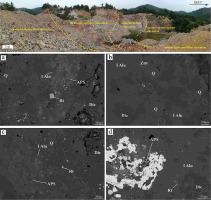当前位置:
X-MOL 学术
›
Ore Geol. Rev.
›
论文详情
Our official English website, www.x-mol.net, welcomes your
feedback! (Note: you will need to create a separate account there.)
Geology and exploration indications of the lithocap in Qianpu area, Luzong Basin, Anhui
Ore Geology Reviews ( IF 3.2 ) Pub Date : 2023-12-10 , DOI: 10.1016/j.oregeorev.2023.105811 Xuanxuan Li , Taofa Zhou , Yu Fan , Jing Chen , Noel C. White , Lejun Zhang , Mingying Tang , Xin Lin , Yao Du , Yuang Zhang
Ore Geology Reviews ( IF 3.2 ) Pub Date : 2023-12-10 , DOI: 10.1016/j.oregeorev.2023.105811 Xuanxuan Li , Taofa Zhou , Yu Fan , Jing Chen , Noel C. White , Lejun Zhang , Mingying Tang , Xin Lin , Yao Du , Yuang Zhang

|
The lithocap is a large-scale alteration including silicification, advanced argillic and argillic that developed near the surface by hydrothermal activities. It is helpful for exploring high-sulfidation epithermal deposits and porphyry deposits in its root and deep parts, respectively, and is used as a new prospecting indicator. There are many minerals in the lithocap and it is difficult to identify them; alunite is the most representative mineral and one of the new minerals used to guide exploration; it plays an important role in assessing the metallogenic potential and guiding ore prospecting. The Luzong basin is dominated by iron oxide apatite deposits (IOAs). In recent years, many researchers have been searching for porphyry copper–gold deposits and epithermal deposits as studies on alunite and lithocaps in the basin have gradually been undertaken. In field explorations and investigations of the Luzong basin, the author found that in Qianpu area of the central basin, where kaolinite deposits were mainly explored in the past, Well-occurring alunite minerals and advanced argillic alterations have developed. A typical lithocap developed in Qianpu area after a series work of geology and mineralogy, such as alteration mineral species, alteration types, and alteration zoning, which were formed by the hydrothermal alteration of the volcanic rocks of the Zhuanqiao Formation. The minerals in this lithocap are mainly quartz, alunite (including aluminum-phosphate-sulfate, APS), pyrite, zunyite, dickite, pyrophyllite, kaolinite, and a small amount of illite, which are present sequentially from the center to the peripheral quartz-alunite-pyrite alteration, alunite-dickite alteration, dickite-pyrophyllite alteration, alunite-kaolinite-illite alteration, and alunite veins superimposed on quartz-alunite-pyrite alteration and alunite-dickite alteration. Three types of alunite were produced in large quantities and were formed in three kinds of environments. The I-type alunite, which was formed by hydrothermal metasomatism alteration in the early stage and is densely disseminated distribution, coexisting with quartz and pyrite, is a magmatic hydrothermal alunite. Relatively pure alunite veins (II-alunite) of varying thicknesses formed in the open space in the mid-hydrothermal period in a magmatic steam environment. The fine-grained III-alunite that coexists with kaolinite formed in the late hydrothermal period and in a steam-heated environment. The alunite produced by various origins represents multiphase hydrothermal activity in the Yanshanian period in the Qianpu area; the Na content decreased, the K and Pb content increased, and the K/Na molar ratios ranged from 2.82 to 6.58 (EPMA) and 1.59 to 3.93 (LA-ICP MS) from the early to middle and late hydrothermal stages, indicating that the formation temperatures were more than 200 °C and gradually decreased with hydrothermal evolution. There is a high-sulfidation epithermal system in Qianpu area. In combination with the specific environmental significance of zunyite indicating a high temperature and closeness to the fluid channel, as well as the characteristics and genesis of the Huangzhuyuan silver polymetallic deposit near Qianpu, it is inferred that the Qianpu-Huangzhuyuan area has prospecting potential for porphyry-epithermal deposits.
中文翻译:

安徽庐枞盆地前铺地区岩盖地质及勘探指示
岩盖是由热液活动在地表附近发育的包括硅化、高级泥质和泥质的大规模蚀变。有助于勘探其根部和深部的高硫化浅成热液矿床和斑岩矿床,可作为新的找矿指标。岩盖中矿物质较多,识别难度大;明矾石是最具代表性的矿物,也是指导勘探的新矿物之一;对评价成矿潜力、指导找矿具有重要作用。吕宗盆地以氧化铁磷灰石矿床(IOAs)为主。近年来,随着盆地明矾石和岩屑研究的逐步开展,许多研究者开始寻找斑岩铜金矿床和浅成热液矿床。笔者在鲁宗盆地野外勘探调查中发现,在过去主要勘探高岭石矿床的盆地中部前铺地区,发育了良好赋存的明矾石矿物和高级泥质蚀变。前铺地区经过一系列蚀变矿物种类、蚀变类型、蚀变分带等地质矿物学研究,形成了颛桥组火山岩热液蚀变形成的典型岩盖。该岩盖中的矿物主要为石英、明矾石(包括磷酸铝硫酸盐,APS)、黄铁矿、祖尼石、地开石、叶蜡石、高岭石和少量伊利石,从中心到外围石英依次存在。明矾石-黄铁矿蚀变、明矾石-地开石蚀变、地开石-叶蜡石蚀变、明矾石-高岭石-伊利石蚀变、石英-明矾石-黄铁矿蚀变和明矾石-地开石蚀变之上叠加的明矾石脉。三种类型的明矾石大量生产,并在三种环境中形成。 I型明矾石是早期热液交代蚀变形成的,呈密集浸染状分布,与石英、黄铁矿共存,是一种岩浆热液明矾石。热液中期岩浆蒸汽环境中的空旷空间形成了厚度不一的较纯明矾石脉(II-明矾石)。与高岭石共存的细粒Ⅲ型明矾石形成于热液期晚期和蒸汽加热环境中。不同成因产生的明矾石代表了前铺地区燕山期的多期热液活动;从热液早期到中后期,Na 含量降低,K 和 Pb 含量增加,K/Na 摩尔比范围为 2.82 至 6.58(EPMA)和 1.59 至 3.93(LA-ICP MS),表明地层温度超过200℃,并随着热液演化而逐渐降低。前铺地区存在一个高硫化浅成热液系统。结合遵义岩具有高温、靠近流体通道的具体环境意义,以及前铺附近黄竹园银多金属矿床特征及成因,推断前铺-黄竹园地区具有斑岩找矿潜力。 -浅成热液矿床。
更新日期:2023-12-10
中文翻译:

安徽庐枞盆地前铺地区岩盖地质及勘探指示
岩盖是由热液活动在地表附近发育的包括硅化、高级泥质和泥质的大规模蚀变。有助于勘探其根部和深部的高硫化浅成热液矿床和斑岩矿床,可作为新的找矿指标。岩盖中矿物质较多,识别难度大;明矾石是最具代表性的矿物,也是指导勘探的新矿物之一;对评价成矿潜力、指导找矿具有重要作用。吕宗盆地以氧化铁磷灰石矿床(IOAs)为主。近年来,随着盆地明矾石和岩屑研究的逐步开展,许多研究者开始寻找斑岩铜金矿床和浅成热液矿床。笔者在鲁宗盆地野外勘探调查中发现,在过去主要勘探高岭石矿床的盆地中部前铺地区,发育了良好赋存的明矾石矿物和高级泥质蚀变。前铺地区经过一系列蚀变矿物种类、蚀变类型、蚀变分带等地质矿物学研究,形成了颛桥组火山岩热液蚀变形成的典型岩盖。该岩盖中的矿物主要为石英、明矾石(包括磷酸铝硫酸盐,APS)、黄铁矿、祖尼石、地开石、叶蜡石、高岭石和少量伊利石,从中心到外围石英依次存在。明矾石-黄铁矿蚀变、明矾石-地开石蚀变、地开石-叶蜡石蚀变、明矾石-高岭石-伊利石蚀变、石英-明矾石-黄铁矿蚀变和明矾石-地开石蚀变之上叠加的明矾石脉。三种类型的明矾石大量生产,并在三种环境中形成。 I型明矾石是早期热液交代蚀变形成的,呈密集浸染状分布,与石英、黄铁矿共存,是一种岩浆热液明矾石。热液中期岩浆蒸汽环境中的空旷空间形成了厚度不一的较纯明矾石脉(II-明矾石)。与高岭石共存的细粒Ⅲ型明矾石形成于热液期晚期和蒸汽加热环境中。不同成因产生的明矾石代表了前铺地区燕山期的多期热液活动;从热液早期到中后期,Na 含量降低,K 和 Pb 含量增加,K/Na 摩尔比范围为 2.82 至 6.58(EPMA)和 1.59 至 3.93(LA-ICP MS),表明地层温度超过200℃,并随着热液演化而逐渐降低。前铺地区存在一个高硫化浅成热液系统。结合遵义岩具有高温、靠近流体通道的具体环境意义,以及前铺附近黄竹园银多金属矿床特征及成因,推断前铺-黄竹园地区具有斑岩找矿潜力。 -浅成热液矿床。


















































 京公网安备 11010802027423号
京公网安备 11010802027423号